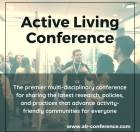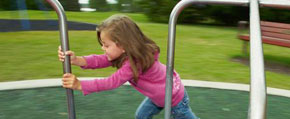We are pleased to announce an exciting new alliance between Active Living Research and GP RED to co-host and coordinate...
Public Open Space and Physical Activity: How Important is Distance, Attractiveness and Size?
Presentation at the 2004 Active Living Research Annual Conference
Background
Walking is the most popular form of physical activity in adults, and public parks or ovals (public open space (POS)) are the third most reported venue for physical activity in Australia (17.3%), after footpaths 56.5% and home 49.5%. Although walking is popular, few people walk 30 minutes daily, the amount required to maximize health benefits. Thus, well-designed public open space that attracts active users is a community asset that has the potential to contribute to the physical (and mental) health of local residents.
Objectives
To examine the impact of distance, attractiveness and size of POS on the use of POS for physical activity, and to examine the association between spatial access to attractive large POS and walking 30 minutes per day on most days of the week.
Methods
An environmental audit of all POS over two acres (n=516) within the study area (a 408 sq km area of metropolitan Perth, Western Australia) and a follow-up observation study of users of the POS involved three pairs of high and low scoring POS matched for size and location. A cross-sectional face-to-face survey of 1803 adults aged 18-59 years (52.9% response rate) that collected data on use of POS for walking, vigorous or moderate activity.
Results
In the two weeks before the survey, 28.8% of respondents used a POS for physical activity (45.6% used the streets, 22.3% the beach and 8.9% the river). We examined the use of POS associated with three models of spatial accessibility, model adjusting for (i) distance, (ii) distance and attractiveness, and (iii) distance, attractiveness and size. We found that the likelihood of using public open space declined with decreasing levels of access, but the effect was greater when the access model was adjusted for attractiveness and size as well as distance from the respondent’s home. The follow-up observational study showed that when POS was matched for size and location, 70% of those observed were using POS with more features. After adjusting for demographic, individual, and social environment factors, those in the top quartile of access to public open space were 47% more likely to walk as recommended (OR 1.47; 95% CI 1.00-2.15).
Conclusions
Our research confirms that adults with good access are more likely to use public open space and to walk as recommended. Moreover, well-designed public open space is more likely to be used compared with space of equal size but with fewer attributes. Public open space has the potential to improve the health and well-being of local residents. Thus, careful consideration needs to be given to the design of space that encourages use, particularly for walking.
- DOWNLOAD "gilescorti_presentation_0.pdf" PDF (2.04 MB) Presentations
STAY UP TO DATE
RECENTLY ADDED TOOLS & RESOURCES
MOVE! A BLOG ABOUT ACTIVE LIVING
The "Active Living Conference" aims to break down research and practice silos and...







